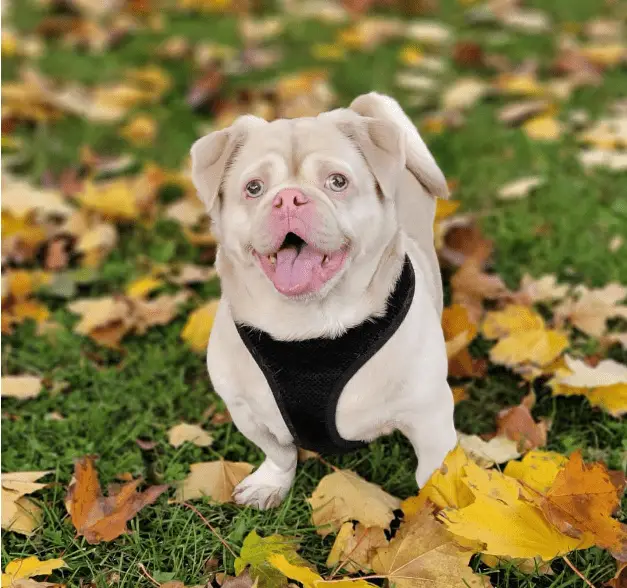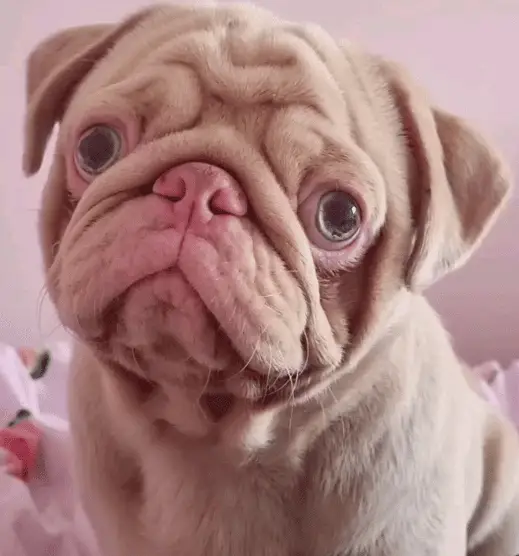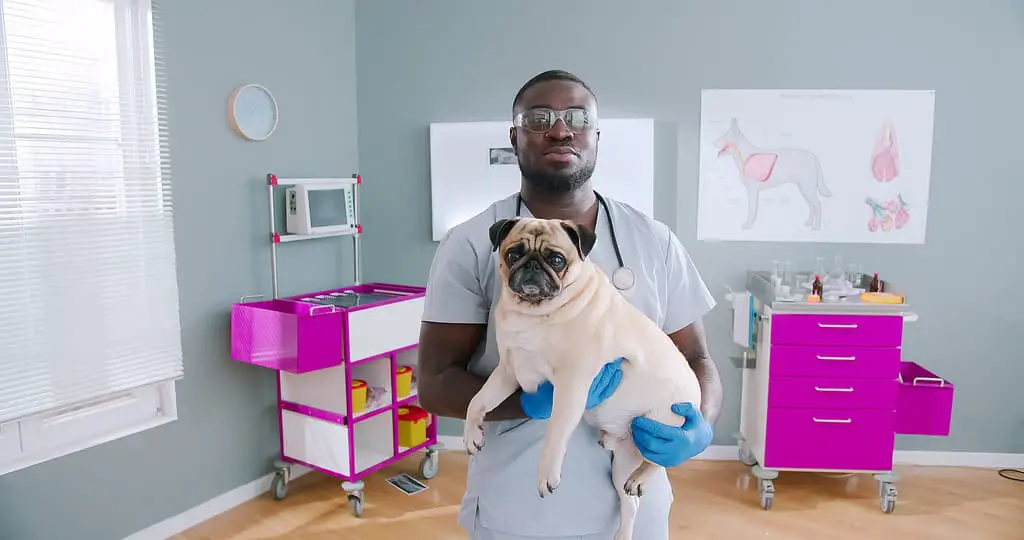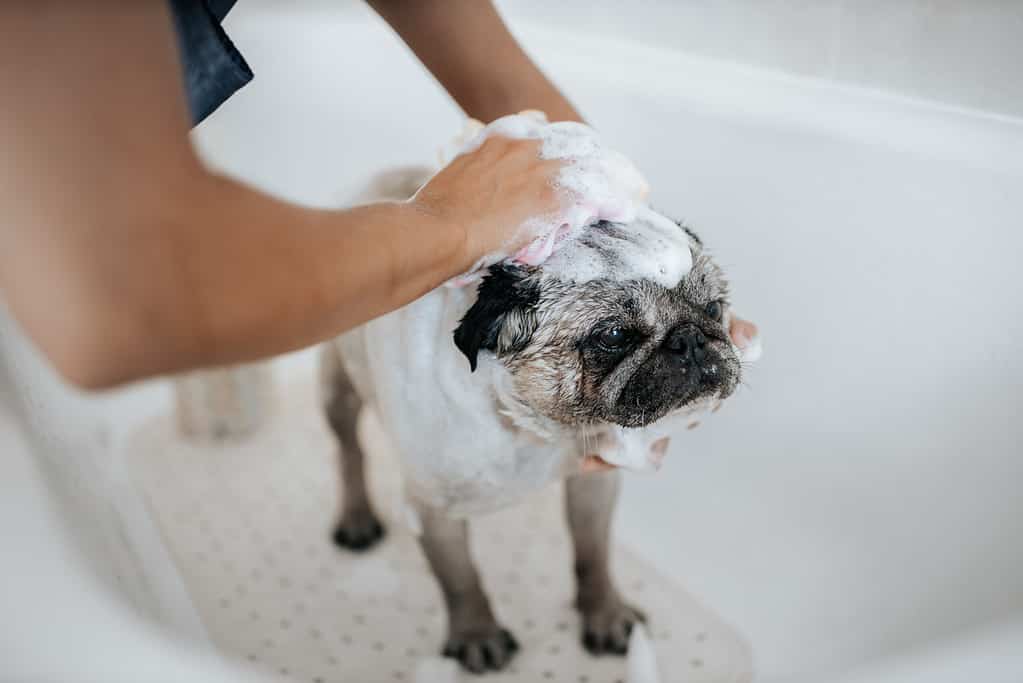Our website is supported by our users. We sometimes earn money when you click an affiliate link and make a purchase. This is at no extra cost to you and helps us to create quality content. Thank you so very much for your support.
Pugs are a small breed of dog with a stable temperament and loving disposition. Most people are familiar with the fawn pugs and black pugs. Those looking for designer dogs, seek after the rare white pug.
These unique dogs have all white fur. Recently, Pugs with a white coat have been growing in popularity.
One popular white pug increased pug lovers interest in owning a different color. Marshmallow the White Pug was an internet sensation that had her own social media pages with thousands of followers. People are fascinated with white dogs, but specifically were endeared to this particular leucistic pug.
History of the White Pug
The white Pug is a rare color variation of the Pug breed, which originated in China over 2,000 years ago. The breed was highly prized by and Tibetan Monks.
In ancient China, they were considered a symbol of good luck and were often kept as pets by Chinese emperors.They were so beloved they were guarded by soldiers and had their own servants.
So, it’s no surprise that when Pugs were introduced to Europe in the 16th century they quickly became popular among European nobility as well.
It is unclear when the first white Pug was born, the American Kennel Club has a breed standard for the pug and therefore recognizes two colors: fawn or black.
The United Kennel Club is an international registry of purebred dogs, and they accept pugs in four colors; silver, black, apricot and fawn. The white coloration is believed to have been the result of a genetic mutation, which is why it is considered rare but is also not accepted by either kennel club.
Despite not being recognized by the breed standard, white Pugs have become popular among dog enthusiasts. They are known for their friendly and affectionate nature, and their distinctive appearance has made them a popular subject for art and advertising.
In recent years, there has been some controversy over breeding white Pugs, as some breeders believe that the white coloration can be associated with health issues such as deafness and skin problems. As with any breed, it is important to choose a reputable breeder who prioritizes the health and welfare of their dogs.
Designer colors are sought out by dog lovers who want a dog that stands out and is unique in appearance. Apricot and silver coated pugs are still considered designer colors in United States. White coated pugs are not purebred dogs, they are considered leucistic or albino.
The Physical Characteristics of the White Pug: Leucistic and Albino
There are three reasons regular pugs can be white coated. It is important to note that leucistic pugs and albino pugs are not the same.
1. Leucism happens due to melanin production being lower than normal.
2. Albinism is when no melanin is produced in the animal.
3. Mixed breeding with white dogs can produce white pug puppies, however they are not purebred dogs.
Dog owners have found there are no specific health benefits or behavior benefits to owning a white pug. Albino pugs are considered genetically flawed and not usually pursued by reputable breeders. Another name given to albino pugs is Pink Pugs.
Leucistic Pugs
Leucism is similar to albinism in that the pigmentation is affected by the melanin levels found in the dogs DNA. This medical condition is caused by different types of genetic mutations that forms the melanin at a cellular level.
The biggest difference between leucistic pugs and albino pugs is one is not completely deprived of melanin or pigmentation.
Leucistic pugs have white coats with traces of pigmentation in their irises, noses, paw pads and or blood vessels.
The eyes of a leucistic pug will be normal color or a darker blue. Features around the mouth will be a deeper shade of pink, and the pug will also have a pink nose.
Although it can be difficult to tell the difference whether or not a white pug is leucistic or an albino pug because both of their fur can be pure white. However, if your dog is blue eyed with a creamy coat (not pure white) to any coat with pigmentation, it is probably leucistic.
Mr. Cornelius of Instagram fame (_mistercornelius) is considered to be leucistic according to owner, Toni Cusson and later confirmed by her vet.

In Toni’s research, Mr. Cornelius’ blue eyes are what lead Toni to her assumption, as albino animals have red eyes due to the total lack of melanin.
However, in regards to albinism according to the Mayo Clinic:
Eyelashes and eyebrows are often pale. Eye color can range from very light blue to brown and may change with age.
With albinism, the colored parts of the eyes, called the irises, usually don’t have enough pigment. This allows light to shine through the irises and makes the eyes extremely sensitive to bright light.
Because of this, very light-colored eyes may appear red in some lighting. Here is Mr. Cornelius with his eyes appearing a little more pink

And here is Mr. Cornelius as a puppy with very pink looking eyes.

Albino Pugs
Albinism can be present in the animal kingdom including in other breeds of dogs. An animal without pigmentation is caused by a mutation in the genes that is responsible for producing melanin. Albino dogs, including white pugs, are considered still considered rare.
The biggest difference of an albino pug is it is completely without melanin, including in every part of their body. The coat will be completely white, as well as the paw pads, and blood vessels. The nose and eyelids can appear pinkish.
As mentioned, a true albino pug’s blue eyes can be any color.
As more proof that Mr. Cornelius might be albino, there is another famous social media Pug in the United Kingdom called Milkshake, (@milkshakethepug) is considered to be an albino Pug, or pink Pug.


Milkshake and Mr. Cornelius have almost identical coloring. Incidentally, they follow each other on Instagram. It may be that Mr. Cornelius is not Leucistic but is actually albino.
As you can see, dog owners can have difficulty telling the difference between a leucistic pug and albino pug. Even vets have a difficult time identifying the distinction because both are so rare.
Temperament & Training of the White Pug
The white Pug is a beloved breed of dog known for its playful, affectionate, and loyal temperament. Like all dogs, Pugs have their own unique personalities.
In terms of nature, Pugs are a brachycephalic breed, which means they have a flat face and shortened snout. This can sometimes lead to respiratory issues, so it’s important to monitor their breathing and make sure they don’t overexert themselves during exercise.
Ideally dog owners want to get their pet moving every single day. Pugs do well with short exercise sessions, such as two 20-minute walks. In warmer weather, pugs can have a harder time breathing, therefore four – 15-minute sessions would work better or merely play indoors on hot days.
Since pugs are happy sleeping all day it is important to also make these sessions fun. Activities these little guys enjoy are “sniffy walks” in the neighborhood, swimming, and even fetch.
Pugs have been known to do well in competition obedience and rally. More active pugs enjoy canine musical freestyle, where the dog and handler work together to preform tricks set to music.
People are drawn to the wonderful temperament of the pug. They are playful with a hint of mischievousness. Pugs have a loving disposition and enjoy being close to their owners.
Pugs need clear communication with house training and obedience training. Choose high quality treats and fun toys for motivation.
Most pug owners describe them as clingy personalities meaning they like to be close to their owners.
Any color pug has an eager to please personality making them easy to train. They are sensitive dogs making them suitable for people of all ages.
Purebred pugs in the classic colors of fawn or black have less health concerns then white pugs, however all pugs can be described as playful and calm dogs.
Proper training and socialization play a big role in shaping a Pug’s temperament. Socializing your Pug from a young age will help them become comfortable around other dogs, people, and new experiences. Training is also important for establishing boundaries and teaching good behavior.
When it comes to training a white Pug, positive reinforcement is key. Pugs respond well to treats, praise, and affection, so use these to reward good behavior. Consistency is also important, so make sure to establish a routine and stick to it.
Overall, the white Pug is a wonderful companion with a fun-loving personality. With proper training, socialization, and care, they can make a great addition to any family.
White Pug Health Issues

While every dog breed usually has certain health problems, the white pug has some serious health concerns. Before bringing home a white dog be aware of the following issues:
Brachycephalic Airway Obstruction Syndrome (BAOS) or Brachycephalic Airway Syndrome
Pugs are one of several breeds of dogs that are considered brachycephalic, meaning they have a flat, wide head and short snout. While this gives them their cute and distinctive appearance, it also means that they are prone to a condition called Brachycephalic Obstructive Airway Syndrome (BOAS).
BOAS occurs when the shape of the dog’s skull and respiratory system leads to difficulty breathing. Symptoms may include snorting, snoring, wheezing, gagging, and exercise intolerance. In severe cases, BOAS can lead to respiratory distress, which requires immediate veterinary attention.
BOAS is a genetic condition, and Pugs that are bred to have extremely short snouts are at higher risk for developing the condition. It is important for Pug owners to be aware of the signs of BOAS and to take steps to minimize their dog’s risk of developing the condition.
This can include avoiding extreme temperatures, providing plenty of rest, and avoiding over-exercise.
In some cases, surgery may be necessary to correct the underlying structural issues that contribute to BOAS.
Breeders that perpetuate Pugs with very flat faces are not unethical breeders. Because this is the breed standard set by kennel clubs. However there are breeders that are breeding Pugs with a longer snout. These dogs are called Retro Pugs and not only bred for a less flat face, they are also bred to be larger.
Pug Dog Encephalitis
This inflammatory disease affects the central nervous system. Symptoms can include seizures, walking in circles and behavioral changes. Dog owners will need to see the guidance of a professional vet for possible treatment options.
Luxating Patella
Small dog owners may notice their dog has a skip in their gait or begin to walk on three legs with one raised higher. A luxating patella is when the kneecap moves out of its normal location.
Stenotic Nares
Pure pugs are susceptible to this genetic fault, however white pugs are even more so. When the nostrils are narrowed or constricted, they will need to be treated surgically. Veterinarians can correct the issues by removing a wedge of tissue from the dog’s nostrils, allowing for improved airflow.
Allergies
Pugs can have allergic reactions to things in their environment, specifically fleas, dust, trees, and pollens. Skin issues can arise due to these allergies. Symptoms can include itching or biting their feet, itching their belly or rashes in the folds of their skin. Allergies can be treated based on the dog’s symptoms.
Obesity
Pugs make great house dogs as they do not demand a lot of exercise to be calm. They love to eat, both their own food and the food on your plate. Pugs are known to overeat which shows up in excessive weight gain. When it’s hard to resist that adorable face, offer your pug healthy treats like blueberries and carrots instead of commercial treats or food from your dinner.
Hip Dysplasia
Often dogs are genetically predisposed to hip dysplasia, but that is not always the case. Proper nutrition, healthy environment and lifestyle are excellent prevention against this health issue.
According to the Orthopedic Foundation for Animals, more than 50% of pugs have symptoms of hip dysplasia.
Symptoms or signs your pug is struggling with this health problem is weakness and pain in the hind legs. The dog might appear wobbly, limb, and avoid climbing stairs as they are difficult.
It is important to take your white pug outside for sniffy walks. Two health issues that are specific to white pugs are sunburns and skin cancer.
Sunburns
Before taking your pug out for a walk, use protection from the sun like a dog approved sunscreen, UV protective dog coats and hats. Keep exposure short during the peak exposure during the day. If your dog likes to swim, remember to reapply sunscreen often.
Skin Cancer
This type of cancer is most often found in older dogs and white dogs. Mast cell tumors are inflamed sores that feel like rubber. Squamous cell carcinomas are firm blemishes that look like warts. Melanomas are unusual colored bumps or lumps found on the lips, mouth, and pads of the feet.
Consult with your veterinarian right away if you suspect an unusual blemish on your pug. Vets may perform a needle aspiration for testing the lump or a biopsy of the area to test for skin cancer.
One serious condition that is inherited is corkscrew tails or ingrown tails. Screw tails are a vertebral malformation causing the tail to be abnormal shape or curvature. Dogs with this tail anatomy are so deformed they are unable to pass feces and will need surgical intervention.
Responsible breeders can prevent many of the health conditions and genetic conditions listed by selective breeding and proper health screening.
Special Care for the White Pug
A well breed healthy pug has the average life expectancy of 12-15 years old. Albino or white pugs need more care than the average pug to have quality of life. When dog owners take these precautions, it can hopefully extend the life of their canine family members.
1. Limit exposure to direct sunlight as white dogs can get sunburn. There are sunscreens that are specially formulated for dogs that is recommended for your white pug (or hairless dogs). Check out this one from EBPP.
2. Visit the vet annually for routine check-ups and stool testing.
3. Select high quality dog food, ideally made from responsibly sourced meat.
4. Avoid unhealthy treats and snacks to prevent obesity.
5. Be intentional about creating fun and easy movement sessions for your dog. Pugs are happy to lay around all day and hang out with their owners.
6. Ask your veterinarian about hip and joint supplements that are effective for small dogs.
7. Brush your pug regularly and check their skin for any abnormalities.
Grooming Your White Pug

A pugs coat is thick (especially in cooler environments) and course. All pugs shed year-round whether it’s the fawn colored, black pug or white pug. How much your dog sheds depend on where they live and the health of the dog. Here are a few tips to keep your little dog feeling and looking their best.
1. Brush their cost two-three times every week to remove dead hair. We recommend these two tools that work well: a wire slicker brush and a metal comb.
2. Daily clean the body wrinkles and facial folds to prevent yeast and bacterial growth. Using a soft cloth or facial round dab with warm water or saline. Carefully wipe down between the folds and be sure they are dry. If you want something quick and gentle you can use these gentle wipes from Chewy.
3. Bathe your dog one to two times a month. Pugs enjoy their bath time but be sure to use a dog friendly shampoo. Always make sure to dry every fold and wrinkle after a bath.
4. Clean the eye area and ears once a week. For eyes, we recommend and for ears we recommend these wipes.
5. Trim nails once a month, short nails are especially helpful for alleviating hind end issues. Give the paws a look over after you trim their nails. Apply paw cream to any cracks or dry pads, we’ve used this one frequently.
If you are nervous to clip your dog’s nails you might try grinding. To learn how to grind your dog’s nails go to our article on How to Grind Your Dog’s Nails Safely If you need help choosing a grinder check out this article on The 5 Best Dog Nail Grinders: Reviews & Guide To Finding the Top Grinder For Your Dog.
Everyone likes a fresh smelling dog, however bathing them too frequently can damage the skin and reduce the natural oils in their coat. The most crucial grooming needs for any pug is keeping the folds and wrinkles clean and dry. Afterall it is this very feature that makes the pug irresistible.
Owning a White Pug
Owning a white Pug can be a wonderful experience, but it is important to consider the costs and responsibilities involved. Here are some things to keep in mind:
Waiting lists: Because white Pugs are a rare color variation, you may need to be patient and get on a waiting list to find a reputable breeder.
Maintenance costs: Pugs, in general, require regular maintenance, including feeding, grooming, and exercise. This can cost around $1,000 a year, depending on the dog’s size, health, and dietary needs.
Medical costs: Pugs are prone to certain health conditions, including BOAS, skin allergies, and eye problems, which may require veterinary care.
Annual medical costs can range from $500 to $1,000, depending on the dog’s health and any treatments required.
Grooming costs: Pugs require regular grooming, including brushing, ear cleaning, and nail trimming. Professional grooming can cost around $50 per session.
Finding a breeder: It is important to find a reputable breeder who prioritizes the health and welfare of their dogs. You can check with local breed clubs or search online for reviews and recommendations.
Drawbacks of owning: As with any breed, there are some drawbacks to owning a white Pug, including their tendency to shed, snore, and require regular grooming. Additionally, their flat faces can make them more susceptible to respiratory problems and overheating, so it’s important to monitor their activity levels and environment.
Fun facts: Pugs are also the official dog breed of the House of Orange in the Netherlands and were once owned by Napoleon’s wife, Josephine Bonaparte.

FAQs on the White Pug
How much is a white Pug worth?
Normal white Pugs can cost between $1,500 and $6,000. The albino variety, on the other hand, is more difficult to locate than a conventional white Pug, and its market value can reach $19,000. However, purchasing an albino Pug entails additional costs for its nutritional and medical requirements.
How long do white Pugs live?
Pugs are relatively hardy and frequently live to be 14 or 15 years old. To help with their weight issues, pugs perform best when they exercise every day.
Famous YouTuber Pewdiepie just said goodbye to his long time companion Pug named Maya. She lived to be a hearty 17 years old.
The Bottom Line on the White Pug
In conclusion, white Pugs are a rare and beloved variation of the Pug dog breed. They are known for their distinctive appearance, friendly temperament, and playful personalities. However, as with any breed, there are certain considerations to keep in mind before owning a white Pug.
White Pugs have a flat, wide head, short snout, and a compact body. They typically weigh between 14-18 pounds and have a height of 10-12 inches.
They are known for their friendly, playful, and affectionate personalities. They are great with children and enjoy being part of a family.
Training: Pugs can be stubborn and may require patience and persistence during training. Positive reinforcement training methods are recommended, and it is important to socialize them at a young age.
White Pugs, like other brachycephalic breeds, are prone to health issues such as Brachycephalic Obstructive Airway Syndrome (BOAS), skin allergies, and eye problems. Regular veterinary care is important to ensure their health and well-being.
Pugs require regular grooming, including brushing, ear cleaning, and nail trimming. Professional grooming is recommended every few months to keep their coat and skin healthy.
Owning a white Pug can be a rewarding experience, but it is important to consider the costs and responsibilities involved. They require regular maintenance, exercise, and veterinary care, and their flat faces can make them more susceptible to certain health issues.
Finding a reputable breeder and providing a loving and safe home is essential to ensure the health and happiness of your white Pug.
Please read our Legal Disclaimer

